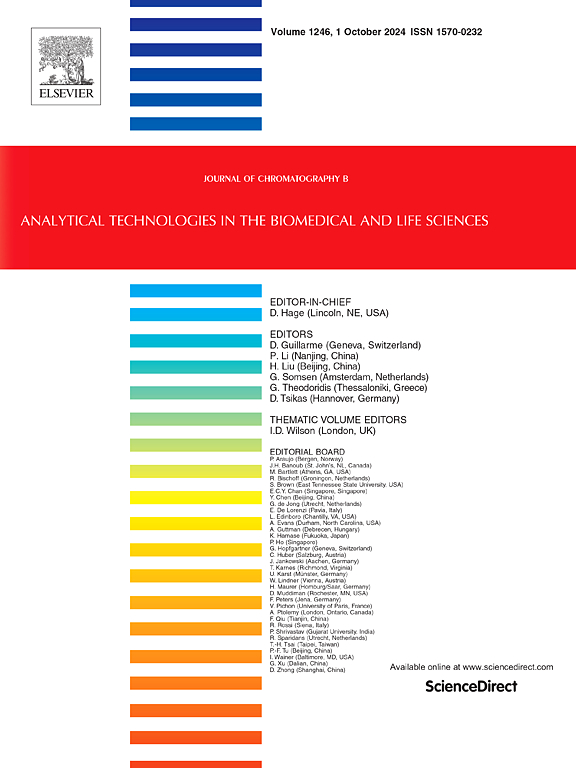使用干血点监测伊马替尼和诺里马替尼治疗:分析和临床验证,以及容量收集装置的性能比较
IF 2.8
3区 医学
Q2 BIOCHEMICAL RESEARCH METHODS
引用次数: 0
摘要
建议在伊马替尼治疗期间监测治疗药物,以优化患者的临床结果。本研究旨在建立一种新的LC-MS/MS方法,使用HemaXis DB10和capitainb装置定量分析体积干燥血斑(DBS)中伊马替尼及其活性代谢物n -去甲基伊马替尼。色谱分离采用XTerra MS C18色谱柱,检测采用SCIEX 4000QTrap串联质谱仪,采用电喷雾正模式电离。根据最新指南成功地进行了分析验证。在240-6000 ng/mL的伊马替尼和48-1200 ng/mL的代谢物范围内,该检测是线性的,在22 - 55%的红细胞比容范围内,这两种设备都是准确的(89% - 113%)和精确的(≤17%的不精度)。回收率在84% ~ 92%之间,不受基质成分的影响。在干燥器条件下(20°C,≤35%湿度)和模拟家庭采样条件下至少43天后,稳定性得到证实。对来自28例患者的52对DBS和血浆样本进行的临床验证表明,DBS与血浆比值可用于将DBS测量值转换为血浆浓度。Bland-Altman和Passing-Bablok分析表明,在两种设备中,伊马替尼及其代谢物的估计血浆浓度和实际血浆浓度非常一致。在另外25 ~ 31个样本上进一步测试了转换方法,80% ~ 97%的样本误差在±20%以内。该研究证明,在伊马替尼治疗期间,使用HemaXis DB10或Capitainer B设备收集的脑深部电刺激可以可靠地替代血浆进行治疗药物监测。本文章由计算机程序翻译,如有差异,请以英文原文为准。
Imatinib and norimatinib therapeutic monitoring using dried blood spots: Analytical and clinical validation, and performance comparison of volumetric collection devices
Therapeutic drug monitoring during imatinib treatment is recommended to optimize patient clinical outcomes. This study aimed to develop a novel LC-MS/MS method to quantitate imatinib and its active metabolite N-desmethyl-imatinib, in volumetric dried blood spots (DBS) using the HemaXis DB10 and Capitainer B devices. Chromatographic separation was achieved using an XTerra MS C18 column and detection occurred with a SCIEX 4000QTrap tandem mass spectrometer using electrospray positive-mode ionization. Analytical validation was successfully performed adhering to the latest guidelines. The assay was linear over the range 240–6000 ng/mL for imatinib and 48–1200 ng/mL for its metabolite, accurate (89 %–113 %) and precise (≤17 % imprecision) across a hematocrit range of 22–55 % for both devices. Recovery ranged from 84 % to 92 %, with no influence of matrix components. Stability was confirmed after at least 43 days in desiccator conditions (20 °C, ≤35 % humidity), and in conditions that mimed home-sampling. Clinical validation, conducted on 52 paired DBS and plasma samples from 28 patients, revealed that the DBS-to-plasma ratio can be used to convert DBS measurements into plasma concentrations. Bland-Altman and Passing-Bablok analyses indicated strong agreement between the estimated and actual plasma concentrations for both imatinib and its metabolite across both devices. The conversion method was further tested on an additional set of 25 to 31 samples, with 80 to 97 % of the samples falling within ±20 % difference. This study proved that DBS collected using either HemaXis DB10 or Capitainer B devices can be reliably implemented as an alternative to plasma for therapeutic drug monitoring during imatinib therapy.
求助全文
通过发布文献求助,成功后即可免费获取论文全文。
去求助
来源期刊

Journal of Chromatography B
医学-分析化学
CiteScore
5.60
自引率
3.30%
发文量
306
审稿时长
44 days
期刊介绍:
The Journal of Chromatography B publishes papers on developments in separation science relevant to biology and biomedical research including both fundamental advances and applications. Analytical techniques which may be considered include the various facets of chromatography, electrophoresis and related methods, affinity and immunoaffinity-based methodologies, hyphenated and other multi-dimensional techniques, and microanalytical approaches. The journal also considers articles reporting developments in sample preparation, detection techniques including mass spectrometry, and data handling and analysis.
Developments related to preparative separations for the isolation and purification of components of biological systems may be published, including chromatographic and electrophoretic methods, affinity separations, field flow fractionation and other preparative approaches.
Applications to the analysis of biological systems and samples will be considered when the analytical science contains a significant element of novelty, e.g. a new approach to the separation of a compound, novel combination of analytical techniques, or significantly improved analytical performance.
 求助内容:
求助内容: 应助结果提醒方式:
应助结果提醒方式:


